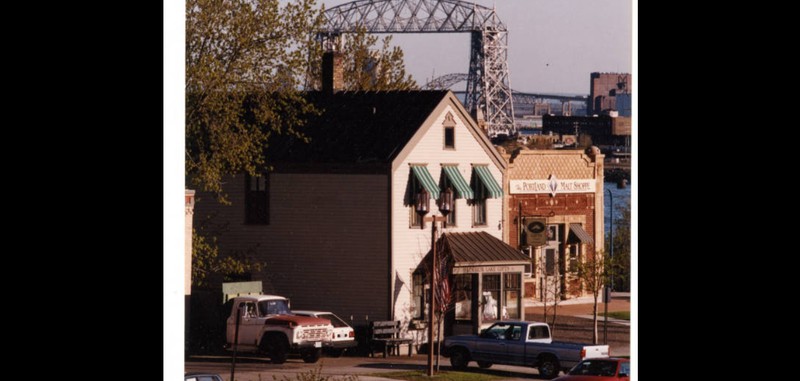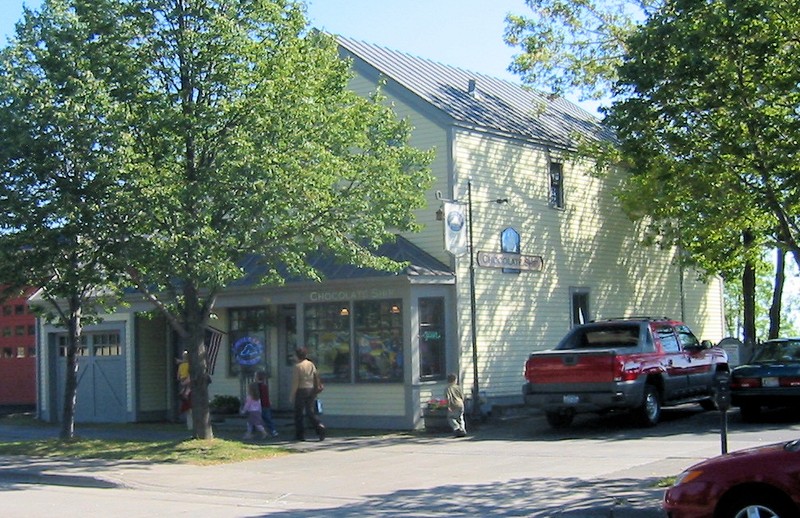Bergetta Moe Bakery Building
Introduction
Text-to-speech Audio
Images
Bergetta Moe Bakery and Superior Street with the Aerial Lift Bridge in the background

2007 photo of the Bergetta Moe Bakery in Duluth

Backstory and Context
Text-to-speech Audio
Construction of the simple, wood-framed, gable-style Bergetta Moe Bakery occurred around 1875 and survives today as one of Duluth's oldest standing buildings. For nearly thirty years, the Bergetta Moe Bakery occupied the house. However, the structure has also been home to such businesses as a coffee shop, residence, hotel, design shop, and specialty chocolate shop. The building represents the construction typically found in the city during its early growth from the 1850s to the 1870s.
Migrating Americans and immigrating Europeans displaced native Ojibew inhabitants in what is now Duluth during the mid-nineteenth-century (notably after 1860). Miners flocked to the area during the 1850s seeking to discover gold or copper, which eventually led them to find an abundance of iron ore. Meanwhile, other entrepreneurs capitalized on nearby rich forests in establishing successful timber companies and saw mills. As mining and milling increased, so did the need for transportation, which led to canal construction and railway extensions to Duluth. As a result, the city experienced a small economic and population boom during the 1860s and early 1870s.
Carrie Ray and James Whitmore took ownership of the land where the bakery now stands shortly after the U.S. Civil War ended in 1865. Records indicate the erection of the building occurred during the 1870s for use as a residence or boarding house. Little is known about the bakery, but it served Duluth during the town's most significant boom from the 1890s until roughly 1930 when the population soared from a little more than 3,400 to more than 100,000 residents. The home served many functions throughout the twentieth century. From around 1970 to 1989, the building housed a design store called the October House. Martin Gould, the owner, also worked in his architectural office located in the lower level of the building. As of 2020, the house operates as a specialty chocolate shop.
This building has stood in Duluth for roughly 145 years and is one of the oldest having been constructed in the town's early years. The structure has seen the turn-of-the-century economic boom, and today Duluth is the largest metropolitan area on Lake Superior and second largest city that is on the lake. Today, the Port of Duluth is the world's farthest inland port (accessible to oceangoing ships) and the busiest port on the Great Lakes. To view the wood-framed home today is to be reminded that today's bustling Duluth started as a Native American village that transitioned to a small, growing city of a few thousand people after the Civil War.
Sources
Gould, Martin F. and Charles W. Nelson. "Nomination Form: Bergetta Moe Bakery." National Register of Historic Places. nps.gov. June 3, 1976. https://npgallery.nps.gov/GetAsset/af19abc4-be68-4fe7-a4a3-d767b5081b1c/.
Moran, Kenneth J. "Aerial Lift Bridge: Superior Street Businesses, Duluth, Minnesota." University of Minnesota-Duluth, Kathryn A. Martin Library, Northeast Minnesota Historical Collections. mndigital.org. Accessed August 8, 2020. https://reflections.mndigital.org/catalog/nemhc:4181
Morse-Kahn, Deborah. Lake Superior's Historic North Shore: A Guided Tour. St. Paul: Minnesota Historical Society Press, 2008.
World Port Source. "Port of Duluth." worldportsource.com. Accessed August 9, 2020. http://www.worldportsource.com/ports/review/USA_MN_Port_of_Duluth_101.php.
https://reflections.mndigital.org/catalog/nemhc:4181
By Elkman - Own work, CC BY-SA 3.0, https://commons.wikimedia.org/w/index.php?curid=4828995
